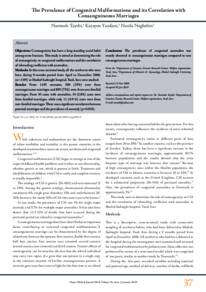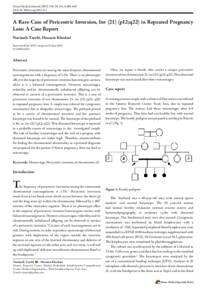وثيقة
The prevalence of congenital malformations and its correlation with consanguineous marriages.
المساهمون
Yazdani, Katayon., مؤلف
الناشر
Oman Medical Specialty Board.
ميلادي
2010-01
اللغة
الأنجليزية
الملخص الإنجليزي
Objectives: Consanguinity has been a long standing social habit among some Iranians. This study is aimed at determining the role of consanguinity on congenital malformations and the correlation of inbreeding coefficient with anomalies. Methods: In this cross-sectional study, all the newborns who were born during 9 months period from April to December 2008. (n=1195) at Shahid Sadoughi hospital, Yazd, Iran were studied. Results: From 1195 neonates, 300 (25%) were from consanguineous marriages and 895 (75%) were from non-familial marriages. From 45 cases with anomalies, 34 (2.8%) cases were from familial marriages, while only 11 (0.9 %) cases were from non-familial marriages. There was a significant correlation between parental marriages and the prevalence of anomaly (p=0.018). Conclusion: The prevalence of congenital anomalies was mostly observed in consanguineous marriages compared to non consanguineous marriages.
المجموعة
URL المصدر
zcustom_txt_2
Tayebi, Naeimeh, Yazdani, Katayon, & Naghshin, Nazila (2010). The prevalence of congenital malformations and its correlation with consanguineous marriages. Oman Medical Journal, 25 (1), 37-40.
قالب العنصر
مقالات الدوريات


